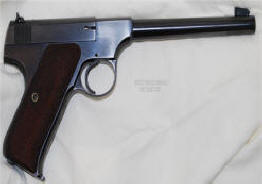
Semi-Automatic
22 LR Pistol
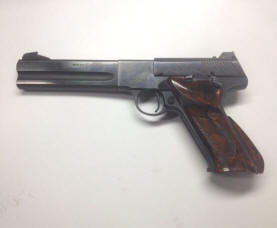
 |
Colt
Woodsman Series Semi-Automatic 22 LR Pistol |
 |
There are three basic series of Woodsman pistols, corresponding to three basic frame designs. There are also some sub-series within the series, like different barrel lengths, sights or grips, etc.
The models referred to here are all those pistols built on the “S” frame as designated by the Colt factory. The First "Woodsman" series would have NOT been marked Woodsman, however for general purposes it is a Woodsman, but for collectors it is called the pre-Woodsman as noted below. The actual First model Woodsman (that had that name on it) as it existed prior to and during World War Two, was basically the same as the pre-Woodsman. The Second Series includes all versions built on the "second" frame design from late 1947 until mid 1955, and the Third Series means the third “S” frame design as used from 1955 to the end of regular production in 1977.
The "S" series is the model number that the Colt factory assigned to this model. Others model designations were "P" for the SSA (Peacemaker), G for the Government model (1911), "I" for the Python, "M" for the 1903/1908 32/380 semi-auto and "N" for the 1908 25ACP, etc.
Pre
Woodsman (1915-1927)
The first Colt 22 RF automatic was marketed as Colt Automatic Target Pistol.
There was no inscription on the LH side of the frame at the location where the
barrel threads into it.
This pre-Woodsman and the First Model can be easily recognized by its distinctive profile,
which resembles the German Luger and the later Ruger Standard model, both having the
rakish rearward grip angle. The grips were
standard checkered walnut. The serial numbers started at #1 which
also provides a sure means of identification, with this serial number located on the front strap of the grip, and contains only numeric
characters, with NO alphabetical suffix characters. Approximately 54,000
of this series were made.
The slides were marked on the LH side “Colt Automatic Caliber 22 Long Rifle” in
2 lines. There were no markings as to model or caliber on the frame or barrel.
These pistols were designed to use only Standard velocity ammo, (which was the only ammo at that time) and this pistol was identified by a checkered thumbprint on the upper rear web of the mainspring housing. This "thumbprint" probably was not the intent at that time, but simply as a roughed area on the backstrap to better secure the gun in the shooter's hand following the pattern on their other models.
The grip-frame bottom was 90 degrees to the magazine with the small magazine latch on the rear of the grip frame securing the upper rear of the magazine in the magazine well. Most of these EARLY magazines had no identifying marks on the bottom. And as a side-note would many times, they could be mistaken and interchangeable with the High Standard A or B models.
Barrels were 6 5/8” long and a step down shoulder at the rear
to a small diameter straight, “pencil barrel” (no taper).
You will note in the photo below that there is no writing on the LH side of frame where the
barrel screws into. And that many of these early guns had the trigger
placed nearer the center of the trigger guard as seen below.
| Colt pre-Woodsman |
 |
Ammo Change If your pistol is pre-WWII, (and has not been altered) it will have a pattern on the mainspring housing, where the web between the thumb and forefinger touches when holding the pistol in firing position. If that pattern is checkered (photo on the left below), it was made for use of standard velocity ammo (as that was all that was available at that time). If it is a pre WWII gun made after 1931, the pattern was changed to horizontal parallel lines (center in the photo below), because these later designed guns all were all designed for the later high velocity ammo which came out in 1931 at about s/n 80,000 of these pistols.
Later the factory did offer conversion kits for usage of High Speed ammo in the early guns. This included a new mainspring housing and recoil spring. However it is possible to have an early standard velocity gun that has just had the recoil spring replaced with the newer high speed version, but the only way to tell on these is tear it apart and look at the recoil spring as identified below. It is not recommended to use the older pistols with the older weaker recoil spring when using the now common High Speed ammo because of possible internal damage to the slide.
After my having the opportunity to look over factory blueprints, the identifying difference of the newer High Speed recoil spring being is that it is wound LEFT HANDED, as compared to the older weaker Standard Velocity spring that is the common right handed wind. I came up with this after which I had the rare chance of looking at copies of original factory blueprints and am probably the only one around that knows this (until now).
Some say that the mainspring housing was made stronger. In all my years as a obsolete firearms parts replacement manufacturer, I seriously doubt this, and the change was simply the horizontal lines to easily identify one from the other. Also in my 60 plus years of gunsmithing, I have seem numerous of the older standard velocity guns still being shot using High Speed ammo. They still seemed to survive, adding to the excellent original design of this firearm, however the most common problem was that the slide would not go forward with enough energy to completely feed or chamber a round (common with a weakened recoil spring being the culprit).
| The original standard Velocity ammo marking on Left, with High Velocity ammo marking on Right | Woodsman pre-war magazine |
 |
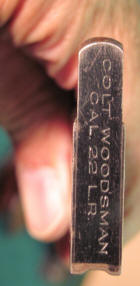 |
Woodsman First
Series (1927-1944/1946)
The normally accepted serial number separating the pre-Woodsman from the "Woodsman" is #54,000. This model is a carry over of the Pre woodsman with the following exceptions. The LH side of the of the frame at the location of the barrel threads is marked ‘The Woodsman”. Approximately 112,000 of this series were made.
The model was the same, serial numbers carried on from the pre series, but at this time the addition of the 4 1/2" sport barrel and the first series Match Target which had a heavy flat sided barrel was introduced. This Match Target model also has a MT prefix to the serial number and these numbers are on the RH side of the bottom of the grip frame as the normal location on the front strap was covered by the larger wrap-around walnut grips.
Again after the introduction of the High Speed ammo in 1931 the recoil spring was changed and this thumbprint was changed to signify HS ammo, at about s/n 80,000. Conversion kits were made available for the older Standard Velocity guns. Some say the mainspring housing/slide stop was made of a different or casehardened material. However it is my educated guess that this is not the case, just that the horizontal parallel lines on the mainspring housing for identification, since they made the recoil spring stronger to accommodate the more powerful round there was really no need to change the housing.
There were 3 sub series, the
(1) Sport model which had a 4 ½” straight taper barrel and a fixed front sight.
(2) Target model with a 6 5/8” barrel tapered barrel with a small front sight base, and the front sight pivoting in with adjustment screw in front for elevation of the sight blade.
(3) The Match Target used a totally different barrel, being flat sided nearly the same thickness as the front of the frame, then running parallel for about 1 ½”, raising to about 1” from the top and then lathe turned in a taper but with the sides still flat, to the muzzle. On the LH side of the flat directly in front of the where the barrel is threaded into the frame, was rollmarked a Bullesye about 1” in diameter, with the words Match above the Bulleseye and Target below. Approximately 16,000 of this series were made.
In the photo below you will notice the writing on the frame where the barrel
screws into that says "The Woodsman". Also note the
trigger moved more rearward in the trigger guard. Triggers were
interchangeable between ALL Woodsmans, even the 3rd series.
| Colt First Series Sport Woodsman |
 |
The grips for the MT were usually made of checkered walnut and wrapped around the front of the grip frame, utilizing one center screw there along with the normal through screw. These wood grips had the sides extending downward, simulating elephant ears by which they were nicknamed.
This Match Target only came with a 6 5/8” barrel and also had adjustable front and a new adjustable Stevens rear sight. This series Match Target was in production from 1938 to 1944. Wartime MT production saw the use of brown plastic grips extending downward near the same configuration of the later 3rd series guns.
The plastic material that the shorter standard grips that were used on the Sport or Target versions was the same as the wartime MT.
The rear sights were normally non adjustable on the Sport or Target pistols.
Magazines for the Pre-Woodsman and 1st series Woodsman are interchangeable no matter the color.
All of the Woodsman series have a unique take down system that retains the recoil spring for easier re-assembly. You will note a small 1/8" peg protruding upward in front of the rear sight and slightly to the side of it. This peg activates a recoils spring retainer that has to be utilized upon reassembly of the slide onto the frame.
The 1938 factory advertisement for the First Series Woodsman Match Target shown below.

Production ceased during WWII for private sales, however some 4,000 Match Target pistols were assembled and issued for military practice purposes up into 1944. These would have been marked "US PROPERTY". And the wooden grips were replaced with newer longer plastic grips. After the war, in 1946, some sporting guns were assembled of existing parts.
Woodsman Second
Series (1947-1952)
The Second Series Woodsmans was a newer, improved redesign of the
1st series, their most predominate distinguishing feature is they have the
magazine bottom being parallel to the barrel, making for a larger grip area.
And they have a automatic slide stop, or hold open device that is activated by
the magazine thumbpiece.
These 2nd Series Woodsmans were the first model that had a
push button magazine release, similar to what was being
used on the Government Model 45.
They also came with the then new Coltmaster adjustable rear sight. There was a
lanyard ring provision incorporated in the bottom rear of the mainspring housing.
Magazines for this series, although made slightly different for the 2nd and 3rd series are somewhat interchangeable. The LATE 3rd series will not latch in place in the 2nd series unless there is a retainer notch cut in the front (some have it while others may not, depending on vintage). However the 2nd series will lock into the 3rd as the latch on them is on the heel of the magazine. More details explained below.
|
Woodsman 2nd series, Sport. Note the similarity
to Colt 1911 45 ACP magazine latch & the adjustable rear sight, with Coltwood grips |
Grip adapters in Coltwood |
 |
|
All post-WWII type Woodsmans, both Second and Third Series, have the serial number stamped on the RH side of the frame at the rear where the barrel is threaded into. An S suffix is added to the serial number. Approximately 146,000 of this Second Series were made.
Barrels were 4 ½” for both the Sport or Match Target, with 6” for the Target and Match Target. Front sights were different on the Sport than the Target models. The Sport had a front sight sloping forward apparently to facilitate a easier draw from a pocket, while the Target and Match Target model's upper rear angled rearward, to give a better non reflective sighting surface. Of the versions offered, the 4 1/2" Match Target is the rarest, because most dedicated target shooters wanted the longer barrel, supposedly for better accuracy.
All barrels of the post War models were screwed into the
frame using LEFT HAND THREADS. This was apparently because of the RH
rifling and IF the barrel was not secured tightly
enough, the bullet rotating inside the barrel and the barrel using RH threads,
the barrel could unscrew, not a common occurrence, but did happen occasionally.
There was a magazine safety feature of the this new series, which made the firearm unfireable with the magazine out. And there is a slide stop inletted into
the LH grip panel, as visible in
the photo above, on all the Woodsmans of this series that slide stop holds the slide back on firing the last shot in the magazine.
This slide stop feature was not available on the economical Challenger, Huntsman or Targetsman,
however the slides could have been machined for it as they probably came off the same
Woodsman production production line before the rear sight cuts were made.
The slide appears to be the same rounded top as the 1st series. All the rear sights used on these early 2nd series models were the Coltmaster. The front sights all were installed in a small silver-soldered on ramp, and the blades were retained by 2 small pins.
The grips were made of “Coltwood” a wood-grained mottled brown/yellow/black Bakelite. The Target and Match Target utilized a thumbrest on the LH grip panel. The Sport version’s LH panel was plain. At some later date the grips went to injection molded brown plastic.
A unique feature of the 2nd series Woodsman is the provision for a grip adapter on the back strap which was made of the same material as the grips. With few exceptions, each originally came with two grip adapters, a large and a small, and were secured by a single screw from the rear.
Now you may see some of the Sport versions with the standard ramp front sight
base but a fixed rear sight
and made from mid-1949 to mid-1950 only.
Although it is part of the Second Series, the Challenger model, (being a economy model) unlike the Woodsman, had a spring catch at the butt and a C suffix to the serial number. The Challenger was a economy model with fixed front and rear sights and made from 1950 to 1955, of which approximately 77,000 were made. These could have either the 4 ½” or 6” barrel, with the shorter barrel more common as these were promoted as a trappers sidearm.
Triggers were usually the curved for the Sport, Challenger and early Target, with the Match Target being grooved and more straight with a forward bend at the bottom. However on some of the early 2nd series you will see the less pronounced arc normally used on the Match Target of the same vintage found on some Targets or even Sport versions as seen in the photo above.
|
Colt Challenger, early version. Note the spring type butt
style magazine latch, brown grips & fixed sights |
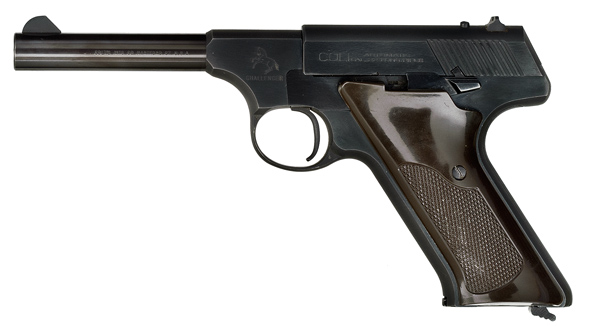 |
Woodsman Second Series, Late (1953-1955)
In 1953 the slide had a center raised rib and a new Accro rear sight was used. This sight was inletted into the top of the slide’s rib, making for a rear sight of less upward protrusion giving it more protection. This is sometimes called the 2nd Series late version.
In the photo below you will notice the new style adjustable rear sight as used on the Target and Match Target guns. Also notice the thumb rest on the LH grip panel also used on the Target and Match Target guns and brown plastic grips.
| Woodsman 2nd series, late Match Target. Note the new style Accro adjustable rear sight & slightly raised rib on slide |
 |
The 3rd Series
replaced the 2nd Series in mid 1955. The most obvious change was the replacement
of the push button magazine release with a new style snap catch at the rear of the butt.
If the magazine
release is at the heel of the butt, AND the pistol has an S at the end of the
serial number, it is a third series.
The trigger guard was made a bit larger, the grip adapters and lanyard ring were eliminated, and the trigger was reshaped.
The magazine
safety, which was a feature of the 2nd series, was carried over to the 3rd
series for a few months, and then was quietly dropped as the parts supply was
depleted.
The sights stayed
the same as the 2nd series except for the Match Target, which went to
the new Elliason target style.
Grips were
originally injection molded black plastic,
but
they were otherwise identical to the late 2nd series brown plastic grips.
In 1960, at about SN 189200-S, Colt switched to real walnut wood which were bulkier
than the previous plastic.
The first 1001 Woodsmans of the 3rd series were assigned serial numbers from the end of the 2nd series serial number block, from 146138-S to 147138-S. The numbers then skipped to 160001-S and restarted.
Note in the RH photo below the new style magazine bottoms were made of a stamped metal that could be removed for cleaning.
The 2nd and 3rd series utilized a automatic slide stop. If the slide stop engages by itself and not ONLY when the last round is fired, in all probability the slide lock spring is either broken or badly bent and or out of position. The problem is usually the spring is not functioning and the lock is not being held down but slightly floats, which bounces around during recoil, intermittently bouncing up at the wrong time.
This spring is a bitch to get in place without pinching/bending
it so it allows the lock to function freely. It is a FINE wire with a
couple of coils in the middle that goes in a hole in the slide lock and with
tails on both ends, one tail under the hex headed screw and it has to be
installed so that tension holds the lock DOWN. It should only be activated
UP on the last shot by the magazine thumbpiece.
Pull the grips off and you should be able to see it in the hole, but all the
rest is hid behind the stop body.
If you take the screw off (do not pull it out), but try to keep it in
position with the stop as you pull the unit out to the left and away from the
gun. And be careful to not remove this on or near a carpet floor.
The hard part is putting it back. What trick I do is to use a Dremel tool
and grind a slight groove in the screw body, under the head for the spring tail
to nestle in. This then allows the tail of the spring a place to be
slightly retained in place as you insert the unit back in place and hopefully
retains it there as you tighten the screw.
You probably will have to do this numerous times to get the tail from not being
slid/locked under the larger screw body shank.
The 2nd series
Challenger was replaced with the very similar model called the Huntsman but continued with the Challenger
C suffix serial
numbers.
Word was, that there
was a model name confusion between the Browning Challenger 22 pistol also on the
market at that time, and the Colt’s pistol of the same name, so Colt changed their name to Huntsman.
The Targetsman, as seen in the photo below,
which came into being in 1959 until 1977 was a just a 6" barreled Huntsman with a economy
fragile adjustable rear sight, also using the C suffix serial numbers.
Some of the internal parts interchanged from the early (even pre-war) models clear into the last versions, these being hammers, hammer plunger, sear and sear spring and trigger bar.
There are more
changes that could be added to this list, depending on how far one wishes to go
with the collection, and on which features the collector considers significant.
An engineering or design change might be an important variation to one
person, and an insignificant item of little interest to another who just wants a
pistol for plinking or packing on a hunting trip. With the many overlapping
changes that took place over the span of years, the possibilities for the
collector are almost
endless.
Post War Serial Numbers ;
All three post-WWII type Woodsmans: Sport, Target and Match Target, both
Second and Third Series, have an S suffix to the serial number. The Challenger
has a -C suffix. The Huntsman (third series) replaced the nearly identical
Challenger when the third series was introduced in 1955. The Targetsman,
which is basically a slightly upgraded 6" Huntsman, was added to the line in 1959.
The Huntsman and Targetsman both continued with the Challenger serial numbers
(-C suffix) until 1969, when the serial numbers of all S frame models then in
production: the Woodsman Sport, Woodsman Target, Woodsman Match Target,
Huntsman, and Targetsman were integrated and restarted at serial number 001001S.
You may encounter zero prefixes which confuse many Woodsman
owners who ignore the zeroes and think they have an early, low serial number
gun. The zero prefix serial numbers caused another problem when the serial
numbers beginning with 001000S reached 099999S and rolled over to 100000S
because serial numbers in that range had already been used in 1951-52 and began
repeating themselves. When the error was discovered 1336 guns had already
been serial numbered, so they were hand stamped with a S prefix creating the
"Double S" prefix/suffix serial number.
This series of
pistols were made in the excess of 690,000 firearms being sold during their
production life of 62 years ending in 1977.
For a link to a factory Woodsman takedown instructions
CLICK
HERE This
is copied off Bob Rayburn's Colt 22 website.
Magazines ;
The pre-WWII
magazines were two-toned until about 1939 or 1940. After that they were
solid blue, but otherwise identical to the previous version. The factory parts
replacement magazines are ALSO solid blue, but the floor plate on them is marked
differently.
These pre-war guns used a magazine with a magazine follower that had a raised
section at the rear, which upon the last round being fired, this upward
protrusion acted as a slide stop.
| Here is shown a pre-war series Woodsman two-toned magazine | Here is shown the slide stop provision of the follower |
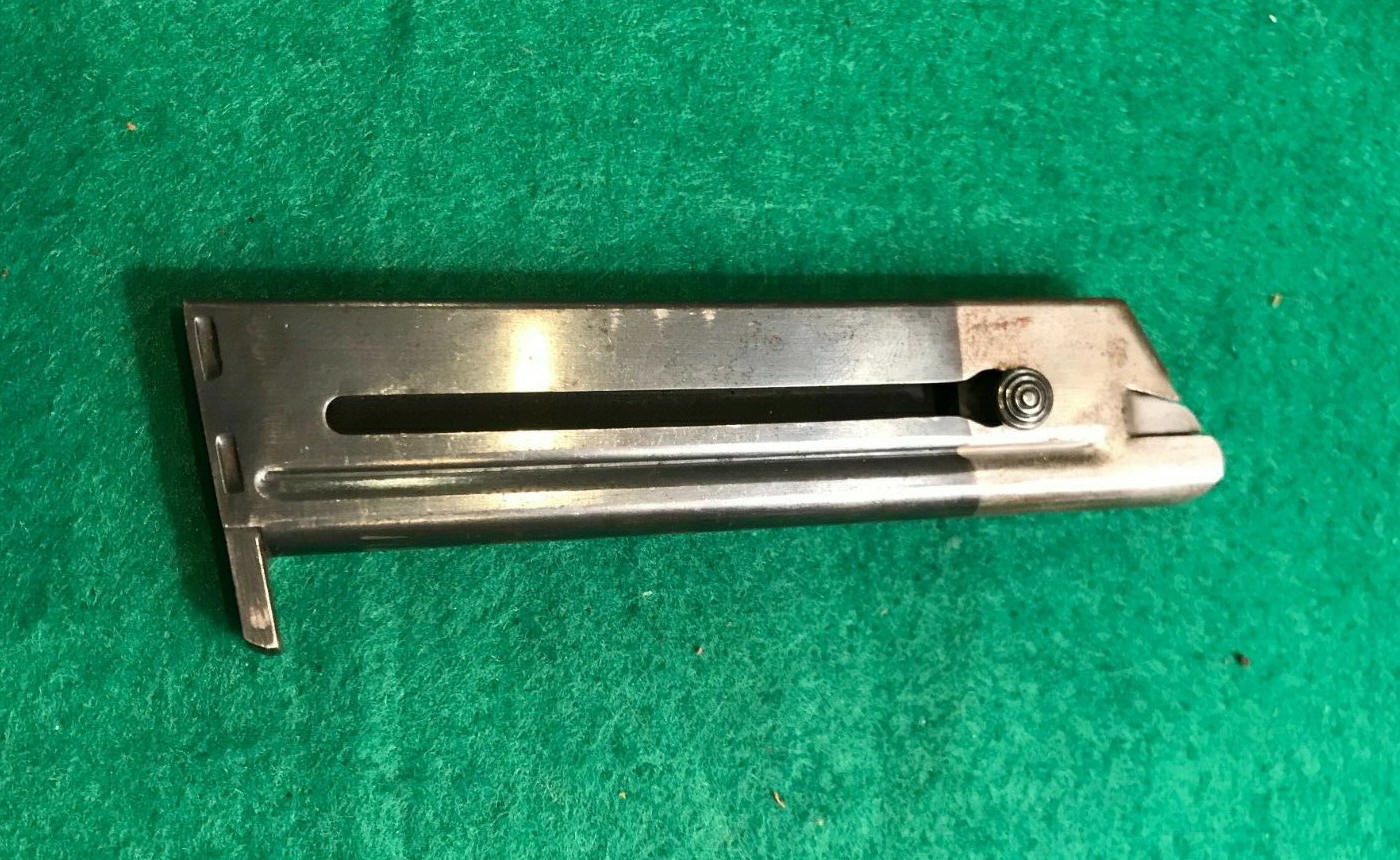 |
 |
The later (post war) magazines were all the
same, (as seen below) but different. The Second and Third Series (ALL VARIATIONS) used a
magazine latch similar to the Colt 1911s, requiring a upper retainer notch.
The Challenger and Huntsman also used this same magazine, however they utilized a rear
bottom frame mounted latch. The factory simply supplied the same Woodsman magazine for
both (where the Challenger and Huntsmans latch used the bottom rear as a
retainer disregarding the upper Woodsman latch notch.)
When the supply of these notched magazines ran out, the next batch did not have
the retainer notch of the earlier versions. The design was slightly
different (simplified) but they fit and operated the same.
| Here is shown a 2nd/3rd series Woodsman magazine with a caliper measuring the notch location to the TOP of the retainer notch |
|
|
The later Cadet and Colt 22 used the same magazine as the later non notched
3rd series magazine, however they were usually made of stainless steel.
If you have a 2nd or 3rd series gun and need a
magazine, any of the Challenger and Huntsman or Cadet and Colt 22 magazine
can be altered buy cutting a retainer notch at the proper location. This
notch location is CRITICAL to proper feeding. The factory notch is .087" wide and
measured from the very inside corner where the bottom
This notch
It is best to grind this notch with ammo in the
magazine and to where your depth comes close, but does not normally touch the bullet. The reason for
this is
the follower coil spring
Copies ;
These guns, like many successful firearms
after patent rights ran out, were copied. There was one made in
South America
Now Comes My Association With the Colt
Woodsman. As a
young man in high school, I ran a trap line EARLY mornings and week-ends during
the winter. I had saved enough money doing farm jobs during the summer and
convinced my mother to purchase me a 22 pistol. Which happened to be a used H&R model 922, with a 6" barrel.
This was the older version without multiple extraction, you had to use the
cylinder base pin to push out each fired case. I
literally wore this gun out, even sent it back to the factory once, I later
wore/chipped the ratchet on the cylinder, so I soft soldered a gob of solder on
the missing section, and with
my pocket knife whittled it down so the cylinder rotated and was timed correctly. When it wore
down again, I just redid the solder job. I got very good at shooting
tree leaves and specks of foam floating down the nearby creek in the winter time.
And during the summer, if I hung a spinner on a alder limb across the creek while fishing for cutthroat
trout, would pull the line tight and shoot the limb off to get my spinner back.
When I turned 21, I got my first Concealed Weapons Permit and that
pistol was a constant companion to me, riding in a Nelson shoulder holster for
MANY years. I could not begin to count how many ruffled grouse that pistol
has accounted for. Or how many deer it has finished off, not to mention
the one or two it got all on it's own. It even finished off a bull elk once
and killed numerous slaughtered beef cattle with it. Or the pigeon who's head was shot
off while sitting on the top of a barn roof with it. And possibly even a few
salmon in the fall, not to mention those ferocious soda cans.
From this association, after becoming a full time gunsmith and being more closely
associated with firearms, I began acquiring more of these little beauties. Before
long I found some that were not listed in any of the reference books available
at that
time. This intrigued me, so if I could not buy one of these different versions, I
would at least make notes as to the differences and serial numbers.
Through my business and attending Washington Arms Collectors monthly meetings, I became acquainted with a man who was collecting
Winchester 22 pump rifles. He also had a few Colt Woodsmans, so we started
comparing notes. This man was Major Robert Rayburn.
Bob soon became more interested in the Colts than the Winchesters, sold the
rifles off and we both pursued collecting Colts. I went for all Colt
automatics, while Bob stayed with just the Woodsmans. We compared notes for a
good many years, gaining insight to these pistols. We had both put together very good Colt collections.
I did some competitive indoor 22 pistol shooting for a while until my eyesight
deteriorated to where I needed cataract surgery. And yes, I shot a Colt Match Target model.
At that time
The only tangible thing I was somewhat willing to part with was my Colt collection
Bob expanded his knowledge, displayed his collection at national
conventions and wrote magazine articles. He even wrote books giving
explicit information not previously published. He put together a website
http://www.colt22.com/ Some of his
data was acquired from visiting the Colt factory achieves. On his website he
has photos of the most frequent problem of reassembling this pistol.
When I sold my collection, the one pistol that did not go was my original Woodsman.
It had by then been transformed into a Sport version by shortening the barrel to 4 1/2",
reinstalling the front sight ramp and replacing the front target blade with a
sport blade.
Many may ask if a longer barrel is more accurate. From my
experience, I did not notice any difference, other than ease of carrying.
To carry on part of the Colt Woodsman tradition, after selling my
collection, I purchased another well used one,
cleaned and reblued it, then and gave it to my oldest grandson when he turned 21.
Then
| Here is my rusty/trusty Woodsman |
|
|
Then
Over the years if you look long enough,
irregularities may appear on any mass produced firearm. This could also be
the case with these Colts. Probably top of the list could be
miss-stamped parts including barrels, slides or even frames. These would
not be considered rare, but more in the category of abnormalities.
You can also see guns with parts being changed somewhere during it's previous
life, (and usually not done at the factory) this would include grips, barrels,
or sights. Gunsmiths can be ingenious at times.
The author does not have any source of parts for any of the firearms listed above
Copyright ©
2014 - 2023 LeeRoy Wisner All Rights Reserved
Back to the Main Ramblings
Page
Originated 11-04-2013, Last updated 04-13-2023